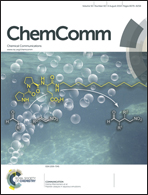Detection of ozone based on its striking inhibition of tris(1,10-phenanthroline)ruthenium(ii)/glyoxal electrochemiluminescence†
Abstract
Ozone unexpectedly dramatically suppresses the electrochemiluminescence (ECL) of Ru(phen)32+/glyoxal at an ozone/glyoxal ratio of less than 0.5%. Moreover, a sensitive, simple and fast ECL method for ozone detection is developed, with a detection time within 1 min and a limit of detection of 20 nM.


 Please wait while we load your content...
Please wait while we load your content...